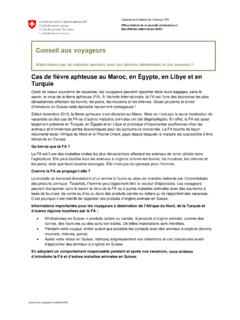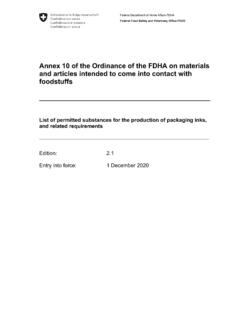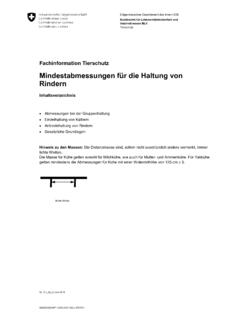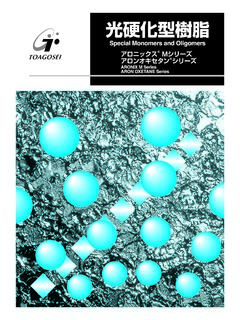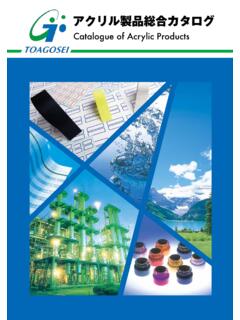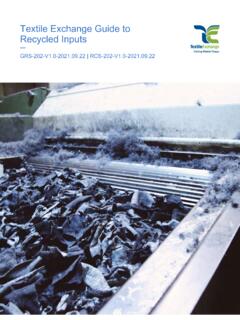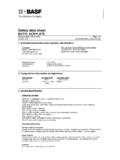Transcription of Lists of permitted substances for the manufacture of …
1 Federal office of public health Annex 6 of the Ordinance of the FDHA on articles and materials of 23 November 2005 (RS ) _____ Lists of permitted substances for the manufacture of packaging inks, subject to the requirements set out therein _____ 4th edition : Entry into force : 1. Ordinance of the FDHA on articles and materials - Annex 6, definitions and explanations Status on 1st December 2012 2/4 Definitions and explanations concerning the Lists I - V I List of binders (monomers) II List of dyes and pigments III List of solvents (including the "energy curing monomers") IV List of additives (without the additives used in the preparation of pigments) V List of photoinitiators Packaging inks may only be manufactured from the substances set out in annex 1 ( Lists I, II and III) and annex 6 ( Lists I - V), subject to the requirements set out therein.
2 The Lists do not include the salts (including double salts and acid salts) of aluminium, ammonium, barium, calcium, cobalt, copper, iron, lithium, magnesium, manganese, potassium, sodium and zinc of the authorised acids, phenols or alcohols which are also authorised. However, names containing .. acid(s), salts appear in the Lists if the corresponding free acid(s) is (are) not mentioned. In these cases, the meaning of the term salts is salts of aluminium, ammonium, barium, calcium, cobalt, copper, iron, lithium, magnesium, manganese, potassium, sodium and zinc . Printed articles and materials shall not release the following substances in quantities exceeding the specific migration limits below: substance SML [mg/kg of food or food simulant] Barium 1 Cobalt Copper 5 Iron 48 Lithium Manganese Zinc 25 Primary aromatic amines, excluding those listed in annex 6, Part A Not detectable (DL = mg/kg of food or food simulant).
3 The detection limit (DL) applies to the sum of the primary aromatic amines released. Ordinance of the FDHA on articles and materials - Annex 6, definitions and explanations Status on 1st December 2012 3/4 Parts A and B The Lists of Part A contain evaluated substances , subject to the requirements set out therein, intended to be used in the manufacture of food contact materials. For the substances without a numerical value in the column SML, the value of the global migration of 10 mg/dm2 or 60 mg/kg according to the cases (cf Art. 3 of annex 1) is considered as the limit value. The substances listed in Part B of the Lists have not been subjected to any officially recognised scientific testing (such as that of the scientific committee of the EFSA). The use of these substances is permitted if no transfer of these substances to food or food simulants can be detected.
4 The relevant proof can be provided by means of a "worst case" calculation or by a practical experiment. The substances in Part B of the Lists must not be detectable in a migration test in the lowest possible concentration at which a substance may be detected using a valid method of analysis. The detection limit depends on the composition of the substance ; this limit, expressed as a concentration, must in no case exceed mg/kg of food or food simulants (including the analytical tolerance). For substances that can be allocated to a group of compounds with similar toxicology or similar basic structure ( isomers), this limit value applies to the sum of the concentrations of the substances . 1 I - List of binders (monomers) The term binders (monomers) is understood to mean all substances involved in the preparation of macromecules such as: a. substances undergoing polymerisation, which includes polycondensation, polyaddition or any other similar processes, b.
5 Natural products or synthetic substances - also of high molecular weight - used in the manufacture or the modification of natural or synthetic macromolecules, The binders (monomers) may be used as additives and inversely, as long as the specific migration limits and the restrictive requirements are respected. 2 IV - List of additives The list IV of the annex includes an exhaustive list of substances , which are: a. incorporated into inks to achieve a technical effect in the finished product and which, in accordance with the use of the finished product, remain there; b. used to provide a suitable medium in which polymerisation occurs ( emulsifiers, surfactants, buffer substances , etc). The list IV of the annex does not include substances which directly influence the formation of polymers ( catalysts) and additives used in the preparation of pigments.
6 The additives may be used as binders (monomers) and inversely, as long as the specific migration limits and the restrictive requirements are respected. Ordinance of the FDHA on articles and materials - Annex 6, definitions and explanations Status on 1st December 2012 4/4 Meanings of the used abbreviations The abbreviations used in the Lists mean: DL = detection limit of the method of analysis EO = ethylene oxide ECM = energy curing monomer FP = finished material or article NCO = isocyanate group QM = maximum permitted quantity of the residual substance in the material or article QM (T) = maximum permitted quantity of the residual substance in the material or article, expressed as the total of the group of the indicated substances QMA = maximum permitted quantity of the residual substance in the finished material or article, expressed as mg per 6 dm2 of the surface in contact with foodstuffs SML = specific migration limit SML (T) = specific migration limit expressed as the total of the group or of the substance (s) indicated MW = molecular weight a.
7 = as w. = with = expressed as s. = cf. = not detectable = analytical tolerance included Ordinance of the FDHA on articles and materials of 23 November 2005 (RS ) Annex 6 Lists of permitted substances from 1 April 2013 for the manufacture of packaging inks, subject to the requirements set out therein I. List of binders (monomers) Part A. evaluated substances Ordinance on articles and materials - Annex 6, List of binders (monomers), Part A : evaluated substances Status on 1st December 2012 2/10 Designation CAS n SML [mg/kg] Remarks Formaldehyde 0000050-00-0 15 (T) w. hexamethylenetetramine Lactic acid 0000050-21-5 Sorbitol 0000050-70-4 D-Glucose 0000050-99-7 Glycerol 0000056-81-5 Palmitic acid 0000057-10-3 Stearic acid 0000057-11-4 Urea 0000057-13-6 Sucrose 0000057-50-1 Linoleic acid 0000060-33-3 Ethanol 0000064-17-5 Formic acid 0000064-18-6 Acetic acid 0000064-19-7 Benzoic acid 0000065-85-0 Methanol 0000067-56-1 Acetone 0000067-64-1 Dimethyl sulphoxide 0000067-68-5 Salicylic acid 0000069-72-7 1-Butanol 0000071-36-3 1-Pentanol 0000071-41-0 Ethylene 0000074-85-1 Acetylene 0000074-86-2 Vinyl Chloride 0000075-01-4 (DL = ) Acetaldehyde 0000075-07-0 6 Ethylene oxide 0000075-21-8 QM = 1 mg/kg in FP Propane, 2-methyl- 0000075-28-5 1 Vinylidene chloride 0000075-35-4 (DL = )
8 QM = 5 mg/kg in FP Carbonyl chloride 0000075-44-5 QM = 1 mg/kg in FP Propylene oxide 0000075-56-9 QM = 1 mg/kg in FP Dicyclopentadiene 0000077-73-6 5 Citric acid 0000077-92-9 1,1,1-Trimethylolpropane 0000077-99-6 6 Vinyltriethoxysilane 0000078-08-0 2-Methyl-1,3-butadiene 0000078-79-5 (DL = ) Isobutanol 0000078-83-1 1 Acrylamide 0000079-06-1 (DL = ) Propionic acid 0000079-09-4 Acrylic acid 0000079-10-7 6 (T) s. annex 1, list Monochloroacetic acid 0000079-11-8 Glycolic acid 0000079-14-1 only to be used behind a PET layer Methacrylamide 0000079-39-0 (DL = ) Methacrylic acid 0000079-41-4 6 (T) s. annex 1, list 2,2-Bis(4-hydroxyphenyl)propane 0000080-05-7 alpha-Pinene 0000080-56-8 Methacrylic acid, methyl ester 0000080-62-6 6 (T) s. annex 1, list Ordinance on articles and materials - Annex 6, List of binders (monomers), Part A : evaluated substances Status on 1st December 2012 3/10 Designation CAS n SML [mg/kg] Remarks Phthalic anhydride 0000085-44-9 Vinylpyrrolidone 0000088-12-0 QMA < 10 g/6 dm (DL = mg/kg) o-Phthalic acid 0000088-99-3 Pyromellitic acid 0000089-05-4 Pyromellitic anhydride 0000089-32-7 ( pyromellitic acid) 2,6-Toluene diisocyanate 0000091-08-7 QM (T) = 1 mg/kg ( NCO) Coumarin 0000091-64-5 2,4-Diamino-6-phenyl-1,3,5-triazine 0000091-76-9 5 3,3'-Dimethyl-4,4'-diisocyanatobiphenyl 0000091-97-4 QM (T) = 1 mg/kg in FP ( NCO) o-Cresol 0000095-48-7 Methacrylic acid, allyl ester 0000096-05-9 Acrylic acid, methyl ester 0000096-33-3 6 (T) s.
9 Annex 1, list Ethylene carbonate 0000096-49-1 30 s. annex 1, list Eugenol 0000097-53-0 (DL = , ) Methacrylic acid, ethyl ester 0000097-63-2 6 (T) s. annex 1, list Itaconic acid 0000097-65-4 Methacrylic acid, isobutyl ester 0000097-86-9 6 (T) s. annex 1, list Methacrylic acid, butyl ester 0000097-88-1 6 (T) s. annex 1, list Methacrylic acid, diester with ethyleneglycol 0000097-90-5 4-tert-Butylphenol 0000098-54-4 alpha-Methylstyrene 0000098-83-9 Isophthalic acid dichloride 0000099-63-8 5 (T) ( isophthalic acid) p-Hydroxybenzoic acid 0000099-96-7 Terephthalic acid 0000100-21-0 Styrene 0000100-42-5 Benzyl alcohol 0000100-51-6 Hexamethylenetetramine 0000100-97-0 15 (T) ( formaldehyde) Methacrylic acid, cyclohexyl ester 0000101-43-9 Diphenylmethane-4,4'-diisocyanate 0000101-68-8 QM (T) = 1 mg/kg in FP ( NCO) Resorcinol diglycidyl ether 0000101-90-6 QMA = mg/6 dm s.
10 Annex 1, list Diphenyl carbonate 0000102-09-0 (1,3- Phenylenedioxy)diacetic acid 0000102-39-6 QMA = mg/6 dm N,N,N ,N ,-Tetrakis(2-hydroxypropyl)ethylenediami ne 0000102-60-3 Triethanolamine 0000102-71-6 SML expressed as the sum of triethanolamine and the hydrochloride adduct expressed as triethanolamine Acrylic acid, 2-ethylhexyl ester 0000103-11-7 Adipic acid, bis(2-ethylhexyl) ester 0000103-23-1 18 N-(4-Hydroxyphenyl) acetamide 0000103-90-2 Ordinance on articles and materials - Annex 6, List of binders (monomers), Part A : evaluated substances Status on 1st December 2012 4/10 Designation CAS n SML [mg/kg] Remarks 1,4-Bis(hydroxymethyl)cyclohexane 0000105-08-8 Methacrylic acid, 2-(diethylamino)ethyl ester 0000105-16-8 Caprolactam 0000105-60-2 15 12-Hydroxystearic acid 0000106-14-9 Butyric anhydride 0000106-31-0 p-Cresol 0000106-44-5 Acrylic acid, isobutyl ester 0000106-63-8 6 (T) s.

